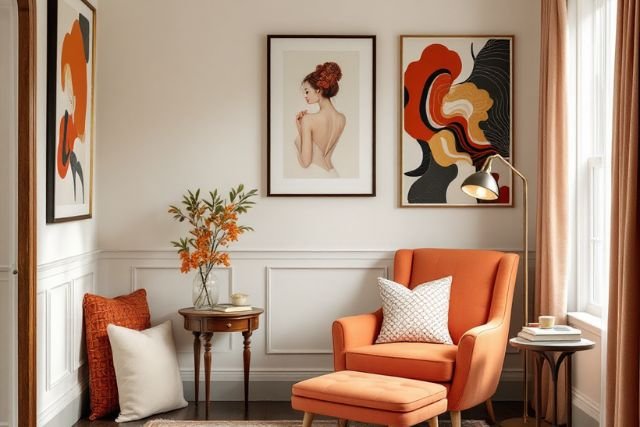Living with fibromyalgia can be challenging, but your home shouldn’t add to that struggle. In fact, with some thoughtful modifications, your living space can become a sanctuary of comfort and ease. Let’s explore how to transform your home into a fibro-friendly haven that supports your well being and helps manage chronic pain.
Why Your Home Environment Matters
For those with fibromyalgia, the home is more than just a place to live—it’s a crucial part of managing symptoms. A well designed space can:
- Reduce pain triggers
- Improve sleep quality
- Enhance overall comfort
- Boost independence and quality of life
So, let’s dive into the key areas where you can make impactful changes.
Ergonomic Furniture: Your Body’s Best Friend
First things first, let’s talk about furniture. The right pieces can make a world of difference in managing fibromyalgia symptoms. Here’s what to look for:
- Supportive chairs with good lumbar support
- Adjustable desks for versatile working positions
- Sofas with firm cushions that don’t sink too much
Remember, comfort is key. Test furniture before buying, if possible. Your body will thank you for choosing pieces that provide proper support and alignment.
Temperature Control: Finding Your Comfort Zone
Many fibromyalgia sufferers are sensitive to temperature changes. To create a more comfortable environment:
- Invest in a smart thermostat for easy temperature adjustments
- Use thermal curtains to maintain room temperature
- Layer clothing and bedding for personal temperature control
By keeping your space at a consistent, comfortable temperature, you can potentially reduce pain flare ups and improve overall well being.
Lighting: Gentle on the Eyes, Easy on the Mind
Harsh lighting can exacerbate fibromyalgia symptoms. Instead, opt for:
- Soft, warm toned bulbs
- Dimmable lights for adjustable brightness
- Natural light where possible, but with options for shade
Good lighting not only reduces eye strain but can also help manage fatigue and improve mood.
Decluttering: Less Mess, Less Stress
A cluttered space can be overwhelming, especially when dealing with chronic pain. To simplify your environment:
- Invest in practical storage solutions
- Keep frequently used items within easy reach
- Regularly purge unnecessary items
A tidy, organized home can help reduce stress and make daily tasks more manageable.
Accessibility Features: Making Life Easier
Incorporating accessibility features can significantly improve your daily life. Consider:
- Installing grab bars in bathrooms and hallways
- Using lever style door handles instead of knobs
- Adding a shower seat for easier bathing
These modifications can help conserve energy and reduce the risk of falls or injuries.
Bedroom Bliss: Creating a Sleep Sanctuary
Quality sleep is crucial for managing fibromyalgia symptoms. To create a sleep friendly bedroom:
- Choose a supportive mattress designed for chronic pain relief
- Use blackout curtains to block light
- Invest in comfortable, breathable bedding
A good night’s sleep can help reduce pain and fatigue, setting you up for better days.
Relaxation Zones: Your Personal Retreat
Designate areas in your home specifically for relaxation. These spaces can include:
- Comfortable seating or lounging options
- Calming decor elements like plants or artwork
- Tools for stress relief activities (e.g., meditation cushions, yoga mats)
Having a dedicated space for relaxation can help manage stress and provide a much needed respite from pain.
Kitchen Considerations: Cooking with Comfort
Make your kitchen more fibro-friendly with these tips:
- Use lightweight cookware and utensils
- Install pull out shelves for easier access to items
- Consider a perching stool for food prep tasks
These changes can make meal preparation less taxing on your body.
Flooring: Soft Steps for Sensitive Feet
Choosing the right flooring can enhance comfort, reduce strain, and create a more supportive space for your daily needs. Consider:
- Low pile carpeting for cushioning
- Anti fatigue mats in areas where you stand frequently
- Smooth transitions between different flooring types to prevent tripping
Comfortable flooring can reduce pain and fatigue from standing or walking.
Smart Home Technology: Convenience at Your Fingertips
Embrace smart home devices to make daily tasks easier:
- Voice activated assistants for hands free control
- Automated blinds and curtains
- Smart lighting systems for easy adjustments
These technologies can help conserve energy and reduce physical strain.
Outdoor Spaces: Bringing Nature Closer
Don’t forget about your outdoor areas. Create a fibro-friendly outdoor space by:
- Installing raised garden beds for easier gardening
- Adding comfortable seating with shade options
- Creating smooth, even pathways to reduce fall risks
Connecting with nature can boost mood and provide gentle exercise opportunities.
The Power of Color: Soothing Hues for Healing
Colors can influence mood and perception of pain. Consider:
- Create a calming space with soft, cool shades of blue and green
- Warm, muted tones for a cozy atmosphere
- Avoiding overly bright or stimulating colors in rest areas
The right color scheme can create a more relaxing and comfortable environment.
Noise Control: Creating a Peaceful Atmosphere
For many with fibromyalgia, noise sensitivity is a real issue. To create a quieter home:
- Use sound absorbing materials like curtains and rugs
- Install double pane windows to reduce outside noise
- Consider white noise machines for consistent, soothing background sound
A peaceful environment can help reduce stress and improve overall comfort.
Personalized Touches: Making It Yours
Remember, while these tips are helpful, everyone’s experience with fibromyalgia is unique. Experiment freely to find what works for you. Your home should reflect your personal needs and preferences.
Conclusion: Your Fibro-Friendly Haven Awaits
Creating a fibromyalgia-friendly home is an ongoing process. Start with small changes and gradually work towards larger modifications. Each improvement, no matter how small, can contribute to a more comfortable and accessible living space.
By focusing on comfort, accessibility, and personal well being, you can transform your home into a supportive environment that helps manage chronic pain and enhances your quality of life. Remember, your home should be a place of refuge and rejuvenation, a space that works with you, not against you, in managing fibromyalgia.
So, take that first step today. Simple changes like cozy pillows or better flow can transform your space into a fibro-friendly haven for comfort and relaxation. Here’s to more comfortable days and restful nights in your fibro-friendly haven!










